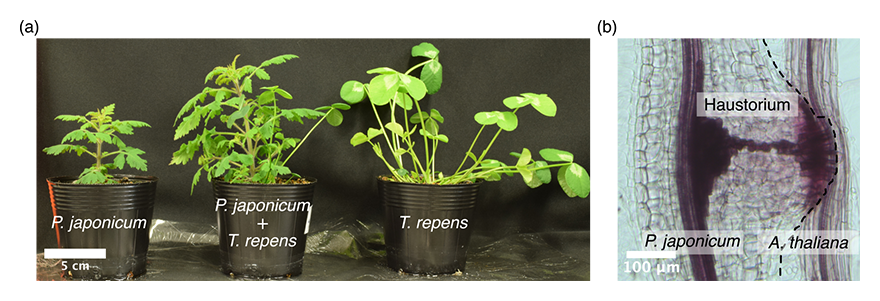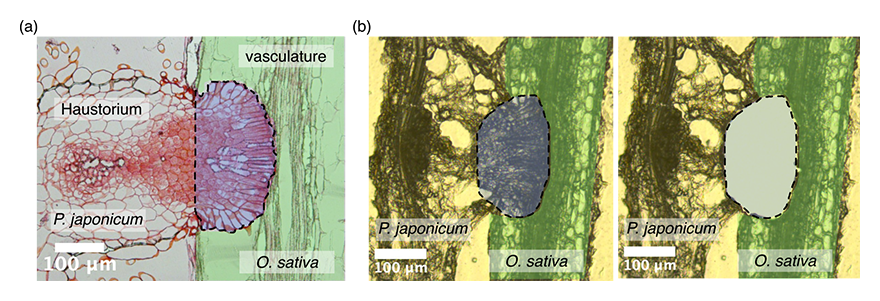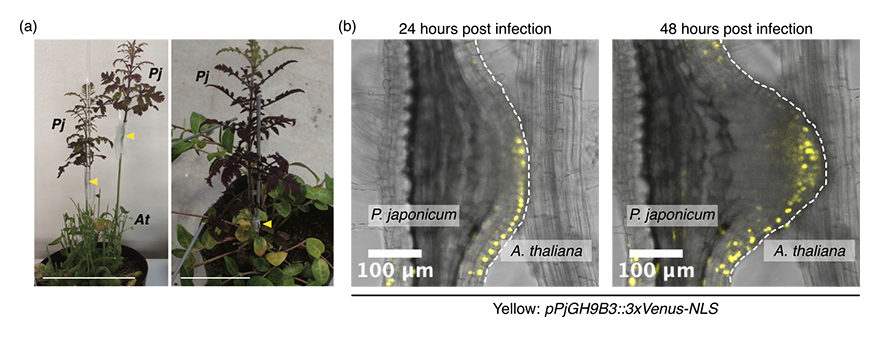2025.04.02
Breaking In: The Enzymatic Tools of Parasitic Plant Invasion
Plant symbiosis ・ Assistant Professor ・ Takanori Wakatake
Parasitic plants are a group of plants that attach to other plants to retrieve nutrients, and it is estimated that there are over 4,000 species, accounting for about 1% of all flowering plants (angiosperms). A common feature among these parasitic plants is the formation of a specialized organ called the haustorium, which penetrates the host plant's tissues and connects to its vascular system to uptake nutrients. Our research group focuses on unraveling the mechanisms of parasitism, primarily studying Phtheirospermum japonicum, a parasitic plant from the Orobanchaceae family. In this article, I introduce two studies that shed light on how P. japonicum invades host plant tissues and the underlying mechanisms that facilitate this process.

Figure1: Phtheirospermum japonicum parasitizes host plants
(a) P. japonicum parasitizing Trifolium repens. After confirming haustorium formation on agar medium, plants were transferred to pots and grown for three weeks. P. japonicum grew larger when attached to a host (middle) compared to when grown alone (left). In contrast, parasitized T. repens exhibited growth retardation (middle) compared to an uninfected plant (right). (b) Haustorium of P. japonicum connecting the xylem to the xylem of Arabidopsis thaliana. The black dashed line marks the outline of the haustorium. Safranin staining highlights xylem vessels.

Figure2: Isolation of intrusive regions from Phtheirospermum japonicum haustorium invading Oryza sativa roots.
(a) A thin section of the P. japonicum haustorium penetrating an O. sativa root. The section is stained by Safranin. (b) Isolation of the intrusive region using laser microdissection from a cryosectioned haustorium. Black dashed lines outline the intrusive region of the haustorium, while O. sativa roots are highlighted in green. (modified from Ogawa et al., 2021)

Figure3: Interfamily grafting of Phtheirospermum japonicum and PjGH9B3 expression at the host interface during early haustorium formation.
(a) Interfamily grafting between P. japonicum (Pj) and Arabidopsis thaliana (At) (left), and P. japonicum and Vinca major (right). Yellow arrows indicate the grafting junctions. Scale bars = 5 cm. (b) Expression pattern of pPjGH9B3::3xVenus-NLS during early haustorium development. The yellow signal represents nuclear-localized Venus fluorescent protein. White dashed lines mark the outlines of haustorium. (modified from Kurotani et al., 2020)
Takanori Wakatake NAIST Edge BIO, e0030. (2025).
